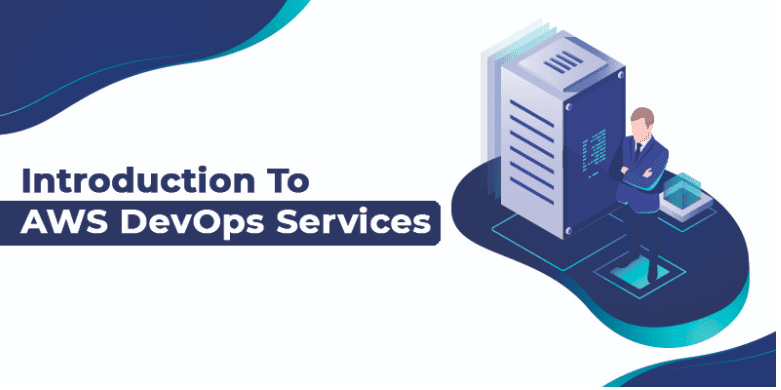Before we discuss AWS DevOps Services, let’s understand a bit about DevOps and AWS Cloud. DevOps is a new methodology in Software Development Lifecycle (SDLC). It’s about bringing collaboration and automation to increase the speed of creating and delivering software.

Before DevOps, software development and the operations team worked in siloes. Both teams didn’t understand the requirements, capabilities, and limitations of either team. They worked within themselves with an aim that didn’t align with the other team. The development team sent the code to the Operations team. to deploy. But upon testing, they found bugs and irregularities that wouldn’t exist if they would have implemented testing and collaboration from the start.
Automation was another aspect that DevOps introduced within the SDLC. They realized that both the development and the operations team had to do redundant and repetitive tasks every time. That’s why DevOps gained much attention from the IT sector. DevOps helped businesses ship software that is more accurate, reliable, and at a much faster rate than what was possible earlier.
Let’s now talk about AWS. Amazon Web Services is the leading Cloud Service Provider that is offering class-leading services across various IT domains. AWS offers its customers many cloud services that include computing, networking, database, storage, analytics, DevOps, Big Data, AI, ML, etc. All of these services are offered on a pay-as-you-go service model for the number of resources that you consumed and the time you used it.
Let’s now talk about AWS DevOps and the services they offer:
Businesses realized the importance of integrating AWS with DevOps. They found that by bringing Cloud to the picture, they can swiftly handle all the processes in the SDLC much more smoothly. And for that, cloud service providers were much happier to offer their top services. Before discussing the AWS DevOps Services, let’s understand the best practices of DevOps. To deep dive into it, one can go through AWS Certified DevOps Engineer training.
Continuous Integration: Developers keep a central repository where they integrate all of their codes, and then it will help you find bugs quicker, enhance software quality, reduce the time to market.
Continuous Delivery: It helps in automatically building, testing, and preparing for a release with frequent code changes. This practice helps developers in possessing deployment-ready artifact that has passed all the test processes.
Microservices: This practice in DevOps helps in designing a single application as a set of small services. Each of these small services will run on its own and communicate with other services via a lightweight API.
Infrastructure as a Code (IaC): This practice helps in provisioning and managing infrastructure as code and using various software development techniques like version control, continuous integration, etc.
Monitoring and Logging: Businesses monitor and log applications, infrastructure performance, and other metrics to gauge customer experience. This practice helps companies gain an overall picture of the ecosystem of their products and the human element in them. They rely on real-time analysis to monitor resources.
Communication and Collaboration: They are probably one of the most important aspects of DevOps. The teams communicate and collaborate using the DevOps tools and best practices to track down bottlenecks, bugs, service irregularities, etc. It helps in bringing the product much faster to the market. The one who understands all these aspects of AWS DevOps could become an AWS Certified DevOps Engineer professional.
Now let’s talk about the various AWS Services in different aspects of DevOps.
CI/CD
AWS CodePipeline: It’s a Continuous Delivery service that helps you model, visualize, automate steps required for a software release. Whenever there is a code change, CodePipeline builds it, then tests, and later deploys the application as per the workflow.
AWS CodeBuild: It’s a Continuous Integration fully-managed service, which helps in compiling source code, running tests, and producing deployable software packages.
AWS CodeDeploy: It’s a Continuous Deployment fully-managed service that will help automate software deployments to computing services like AWS Lambda, EC2, Fargate, etc. This service helps avoid downtime, release new features, and handle application update complexities.
Microservices
Amazon Elastic Container Service (ECS): It’s a Container orchestration fully-managed service that helps you deploy, manage, and scale containerized applications.
Amazon Lambda: It’s a serverless compute service that helps you run code without provisioning or handling servers, in other words, without any form of administration.
Infrastructure as Code
AWS CloudFormation: This service helps you as a developer to create AWS resources in an orderly manner. Then the CloudFormation template is deployed as a stack in the AWS platform.
AWS Config: It’s a fully-managed service that offers you AWS resource inventory, configuration change notifications, configuration history, etc.
If you are prepping up for an interview, check out AWS DevOps interview questions to ace the interview and bag the opportunity.
Monitoring and Logging
Amazon CloudWatch: This service metrics automatically collects data from AWS services like Amazon EC2, EBS Volumes, RDS DB instances, etc. These metrics are then organized to create dashboards, alarms, events, etc.
AWS X-Ray: It helps AWS Developers analyze and debug distributed production applications built using microservice architecture. This service will help you understand how the built app is functioning, and you can use this to troubleshoot the root causes of any issue.
Conclusion:
There are various services that AWS DevOps offers to its developers. These services are either managed or fully-managed services, which will help both operations as well as the development team in easing the SDLC processes.



